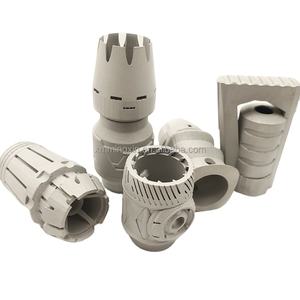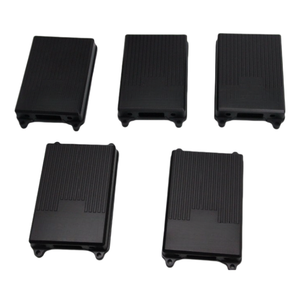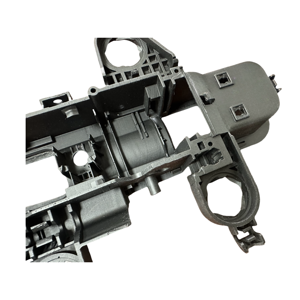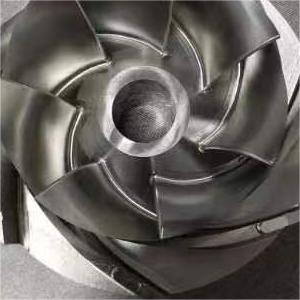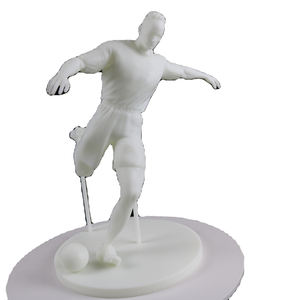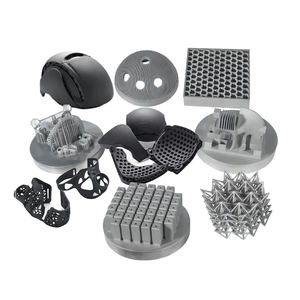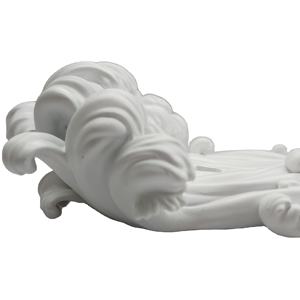Discover a professional 3D printing powder supplier
PRODUCT PARAMETERS
Description
Overview of Custom High Precision SLA/SLS 3d Printing Metal Service Plastic Prototyping
3D printing, also known as additive manufacturing, is a transformative technology that allows the creation of three-dimensional objects by depositing materials layer by layer based on digital designs. This process opens up a new world of possibilities in product design, customization, and production, revolutionizing various industries including healthcare, aerospace, automotive, consumer goods, and more.
Customization & Personalization: One of the key advantages of 3D printing is its ability to create highly customized products tailored to individual needs or preferences, from prosthetics to fashion accessories.
Complex Geometry: 3D printing excels at producing intricate shapes and geometries that would be extremely challenging or impossible to manufacture using conventional methods, such as internal lattice structures or organic forms.
Rapid Prototyping: It significantly speeds up the product development cycle by enabling designers and engineers to quickly produce physical prototypes for testing and refinement.
On-Demand Manufacturing: The technology supports small-batch or even one-off production runs economically, reducing the need for large inventories and allowing for just-in-time manufacturing.
Material Diversity: A wide range of materials can be used in 3D printing, including plastics, metals, ceramics, composites, and even biomaterials, each offering unique properties for specific applications.
Reduced Waste: As compared to subtractive manufacturing techniques, 3D printing only adds material where needed, leading to less waste and a more sustainable manufacturing process.
Features of Custom High Precision SLA/SLS 3d Printing Metal Service Plastic Prototyping
Design Flexibility: The technology enables the realization of complex designs without the constraints of traditional manufacturing tools and molds.
Functional Integration: Parts can be designed with integrated features such as channels, cavities, or interlocking components, which can enhance functionality or simplify assembly.
Lightweight Structures: Advanced 3D printing techniques allow for the creation of lightweight yet strong structures through optimized designs and the use of lattice structures or composite materials.
Improved Performance: By precisely controlling material composition and structure, 3D printed parts can exhibit enhanced mechanical, thermal, or electrical properties.
Cost-Efficiency for Complexity: While 3D printing may not always compete with mass-production methods for simple parts, it becomes increasingly cost-effective as the complexity of the part increases.
Innovative Applications: From medical implants that match a patient’s anatomy perfectly to aerospace components that reduce weight and increase efficiency, 3D printing pushes the boundaries of what’s possible in product design and engineering.
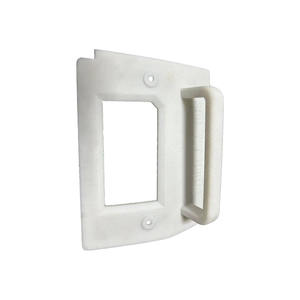
(Custom High Precision SLA/SLS 3d Printing Metal Service Plastic Prototyping)
Specification of Custom High Precision SLA/SLS 3d Printing Metal Service Plastic Prototyping
Custom High Precision SLA/SLS 3D Printing Metal Service Plastic Prototyping delivers detailed parts for industrial and technical applications. This service uses advanced SLA (stereolithography) and SLS (selective laser sintering) technologies. These methods create complex geometries with tight tolerances. Materials include metals like aluminum, stainless steel, titanium, and engineering plastics such as nylon, resin, and ABS. Parts achieve high accuracy, with layer resolutions down to 25 microns. Surface finishes remain smooth, reducing post-processing needs.
The process starts with digital 3D models. Files are optimized for printability. SLA employs UV lasers to cure liquid resin layer by layer. This suits intricate designs needing fine details. SLS uses lasers to fuse powdered materials. This works for durable, functional prototypes. Both methods support rapid turnaround, with parts ready in 1-5 days.
Metal prototypes handle high-stress environments. Applications include aerospace components, medical tools, automotive parts, and custom machinery. Plastic parts serve consumer electronics, product design, and functional testing. Tolerances range from ±0.1 mm to ±0.3 mm. Wall thickness starts at 0.5 mm. Maximum part sizes reach 500 x 500 x 600 mm for SLS and 450 x 450 x 300 mm for SLA.
Quality control involves dimensional checks, stress testing, and surface inspections. Each part meets ISO 9001 standards. Custom finishes like polishing, painting, or coating are available. Low-volume production runs are supported.
The service suits engineers, designers, and manufacturers needing precision prototypes. It bridges the gap between concept and mass production. Costs stay competitive for small batches. Design flexibility allows adjustments mid-process. Technical support assists with file preparation and material selection.
Lead times depend on part complexity and quantity. Standard orders ship within a week. Expedited options reduce wait times. Shipping is global. Packaging ensures parts arrive undamaged.
Materials are chosen for strength, heat resistance, or biocompatibility. Metal parts undergo sintering or infiltration for density. Plastic parts avoid tooling costs. Functional testing validates performance. Iterations are fast, speeding up product development.
This service supports industries requiring reliable, high-quality prototypes. It combines advanced technology with practical solutions.
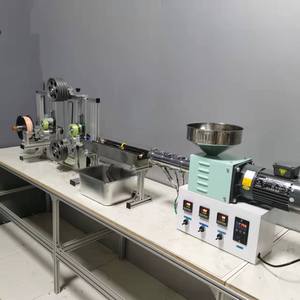
(Custom High Precision SLA/SLS 3d Printing Metal Service Plastic Prototyping)
Applications of Custom High Precision SLA/SLS 3d Printing Metal Service Plastic Prototyping
Custom high precision SLA/SLS 3D printing services for metal and plastic prototyping offer advanced solutions across industries. These technologies create detailed parts with tight tolerances. SLA uses lasers to cure liquid resin layer by layer. SLS uses lasers to fuse powdered materials. Both methods produce durable prototypes and end-use components.
Aerospace companies rely on these services for lightweight parts. Complex geometries reduce weight without sacrificing strength. Heat-resistant metals and plastics handle extreme conditions. Turbine blades, sensor housings, and brackets are common examples. Stress tolerance and thermal stability meet strict industry standards.
Automotive manufacturers use SLA/SLS for rapid prototyping. Engine components, interior panels, and custom fittings are tested before mass production. Functional prototypes validate designs quickly. Time and costs drop compared to traditional methods. Custom tools and fixtures streamline assembly lines.
Medical fields benefit from patient-specific solutions. Surgical guides, dental models, and prosthetics require precise customization. Biocompatible materials ensure safety for implants. 3D printing allows adjustments based on scans. Hospitals and labs get devices tailored to individual needs.
Consumer electronics brands use these services for product development. Prototypes like casings, connectors, and buttons test form and function. Ergonomic designs improve user experience. Small batches help validate market demand before scaling. Rapid iterations speed up time-to-market.
Industrial manufacturers apply SLA/SLS for functional tooling. Jigs, molds, and assembly aids optimize production. Durable materials withstand repeated use. Complex parts are made in one piece, reducing assembly steps. Factories maintain efficiency with minimal downtime.
High precision 3D printing supports research and development. Engineers test concepts without expensive tooling. Design flaws are identified early. Material options include nylon, titanium, and engineering-grade resins. Industries achieve faster innovation cycles.
The versatility of SLA/SLS meets demands for accuracy and speed. Custom parts bridge the gap between prototyping and full-scale production. Businesses adapt to changing needs while maintaining quality.
Company Profile
3D Printing Passion is a trusted global chemical material supplier & manufacturer with over 12-year-experience in providing super high-quality 3D printing powder and relative products.
The company has a professional technical department and Quality Supervision Department, a well-equipped laboratory, and equipped with advanced testing equipment and after-sales customer service center.
If you are looking for high-quality 3D printing materials and relative products, please feel free to contact us or click on the needed products to send an inquiry.
Payment Methods
L/C, T/T, Western Union, Paypal, Credit Card etc.
Shipment
It could be shipped by sea, by air, or by reveal ASAP as soon as repayment receipt.
5 FAQs of Custom High Precision SLA/SLS 3d Printing Metal Service Plastic Prototyping
What materials work with custom SLA/SLS 3D printing?
Plastics and metals are both options. SLA typically uses resins like standard, tough, or flexible grades. SLS uses nylon-based powders. Metals include stainless steel, aluminum, or titanium. The process depends on the material.
How accurate are SLA/SLS printed parts?
SLA offers high precision. Layer resolutions can hit 0.1mm. SLS is slightly less precise. Tolerances reach around 0.3mm. Accuracy depends on machine calibration and part design. Complex geometries might need extra support.
What’s the average lead time for prototypes?
Simple prototypes take 3-5 days. Larger batches or complex designs add time. Post-processing like sanding or coating extends deadlines. Rush services are sometimes available.
Can SLA/SLS parts handle functional testing?
Yes. Plastic parts from SLS withstand moderate stress. SLA resins suit static models better. Metal-printed parts handle higher loads. Material choice impacts performance. Discuss application needs with the provider.
What factors affect pricing?
Material costs vary. Metals cost more than plastics. Part size and volume matter. Post-processing adds expenses. Bulk orders often lower per-unit costs. Request a quote for exact pricing.

(Custom High Precision SLA/SLS 3d Printing Metal Service Plastic Prototyping)

